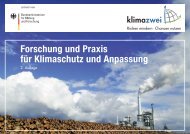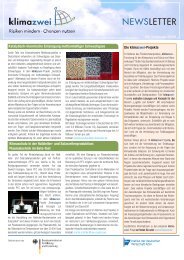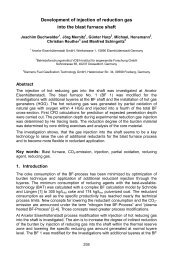iaf ⢠institut für angewandte forschung pforzheimer ...
iaf ⢠institut für angewandte forschung pforzheimer ...
iaf ⢠institut für angewandte forschung pforzheimer ...
Erfolgreiche ePaper selbst erstellen
Machen Sie aus Ihren PDF Publikationen ein blätterbares Flipbook mit unserer einzigartigen Google optimierten e-Paper Software.
Anhang C: Konferenz-Abstracts<br />
C.2: Abstract für die International Society for Industrial Ecology<br />
Conference (ISIE) 2005 in Stockholm<br />
Ecological Benchmarking on Company Level: Measuring the Ecological Efficiency of Sites<br />
or Companies<br />
Prof. Mario Schmidt, Regina Schwegler<br />
Institute for Applied Research, University of Applied Sciences Pforzheim, Germany<br />
Life Cycle Assessment (LCA) methods that have been developed in recent years allow for the<br />
comparison of ecological advantages and disadvantages of products and services. However,<br />
how can the ecological performance of entire production sites or companies be compared? In<br />
this case, it is difficult to define a functional unit as a standard of comparison: A site or company<br />
generally produce many products, so that working out complete LCAs for each of them would<br />
mean too much of an effort. Nevertheless, being able to compare different sites or companies is<br />
quite important, as on this level many significant decisions are made about ecological<br />
positioning within markets and society.<br />
As the result of a research project funded by the German federal state of Baden-Wuerttemberg,<br />
a system of environmental performance indicators has been developed, trying to reach the<br />
following aims: The main intention was to measure environmental efficiency on a company<br />
level, not a product level. To achieve this, the resulting benefits needed to be confronted with<br />
the ecological damage of a site. The indicator system should therefore allow for the comparison<br />
of different production sites as well as of the same site over time, taking into account different<br />
and changing product portfolios and vertical ranges of manufacture. The second challenge was<br />
to consider a comprehensive ecological responsibility that a company bears beyond the<br />
ecological impact of the specific site. And thirdly, the effort to implement and utilize the<br />
indicator system should be minimized in order to make it suitable for practical usage. Therefore,<br />
managers should be able to calculate the indicator quite easily, preferably by using data<br />
provided by their accounting system or which can be obtained simply. This can be difficult,<br />
especially as value-added chains have become more and more globalized while vertical ranges of<br />
manufacture have become shorter. Thus, in some industries, getting information about the<br />
entire supply chain is rendered almost impossible.<br />
The indicator system that the Institute of Applied Sciences in Pforzheim has succeeded in<br />
developing meets all of the three above-mentioned criteria. Representing environmental impacts<br />
of companies for the time being, the focus has been laid on climate impacts, measured by the<br />
global warming potential (GWP) of green house gas (GHG) emissions. In principle, it is also<br />
possible to chose and quantify other impacts such as toxicity, acidification or ozone depletion.<br />
The generated formula, allowing for an easy calculation of the climate efficiency of a production<br />
site or a company, takes into account extended ecological responsibility for GHG emissions in<br />
the following ways:<br />
Firstly, it includes the climate efficiency of suppliers in a coherent and easy way, alleviating the<br />
problem of allocating GHG emissions to the various products that are produced by a specific site<br />
or company: It has become possible to avoid the effort of assigning a site’s production processes<br />
to its specific products and of measuring their respective GHG emissions. Additionally,<br />
methodological problems of allocating emissions to products in the cases of joint-product<br />
production are solved by introducing a simple, yet stringent allocation system. Last but not least,<br />
the organizational effort of obtaining the data of the supply chain is minimal.<br />
Secondly, reduction processes for the disposal of waste can be introduced into the indicator<br />
system as well. The fundamental idea of the indicator system and the type of extended<br />
106







